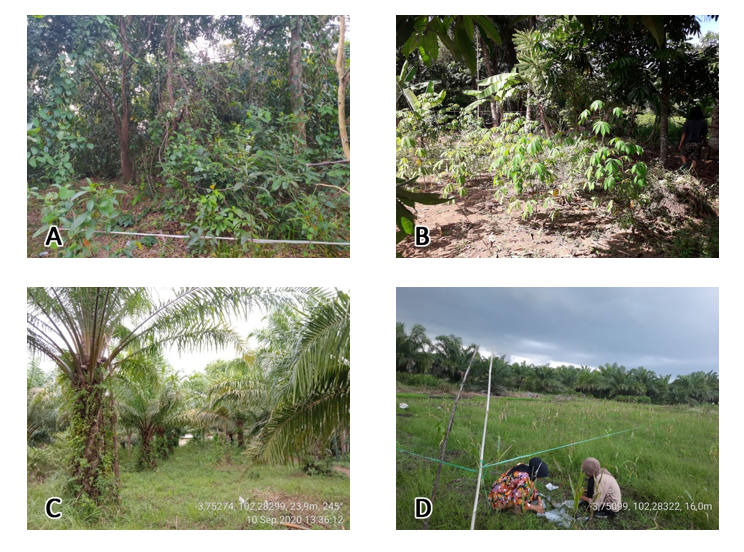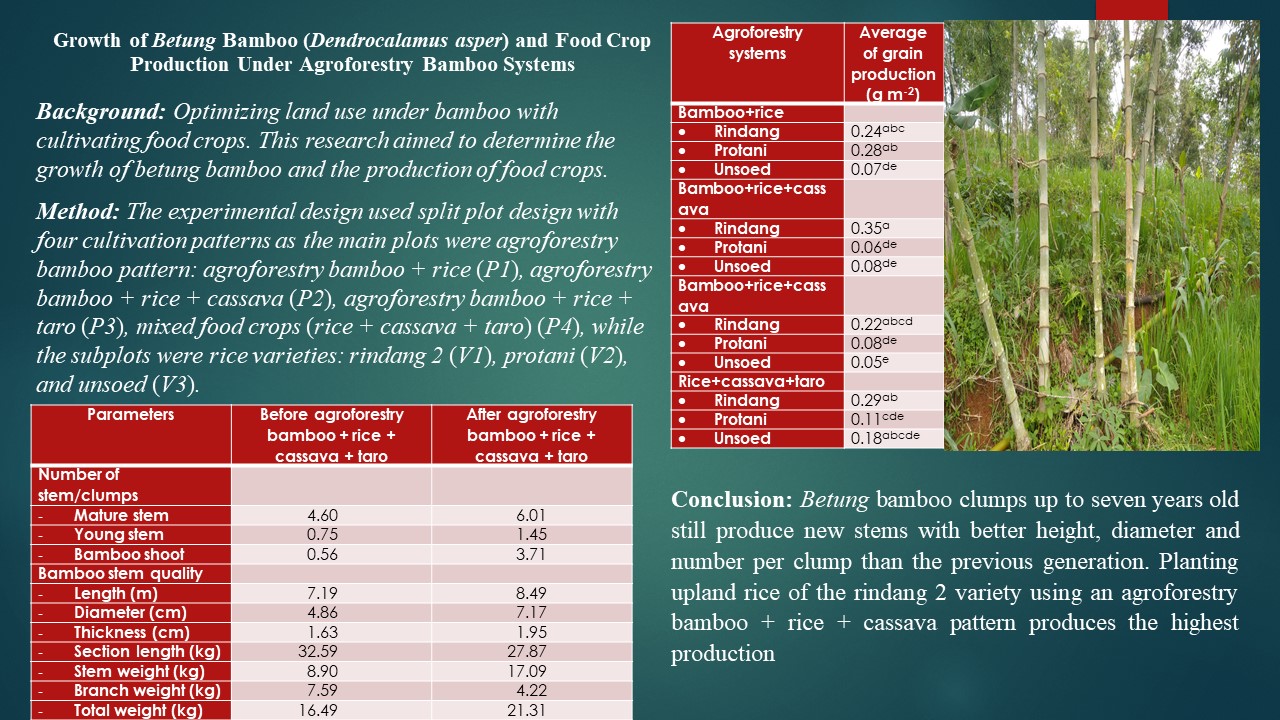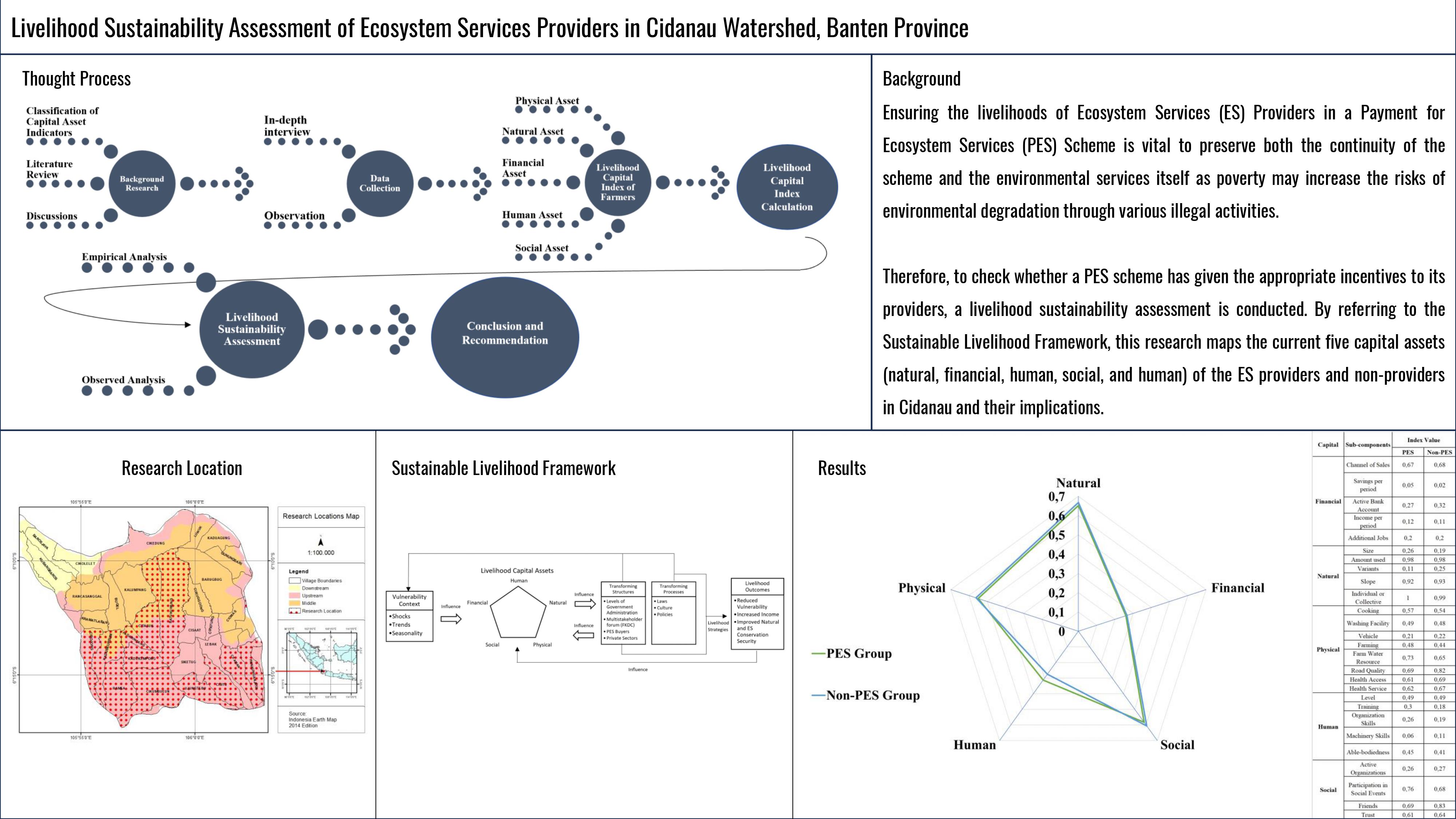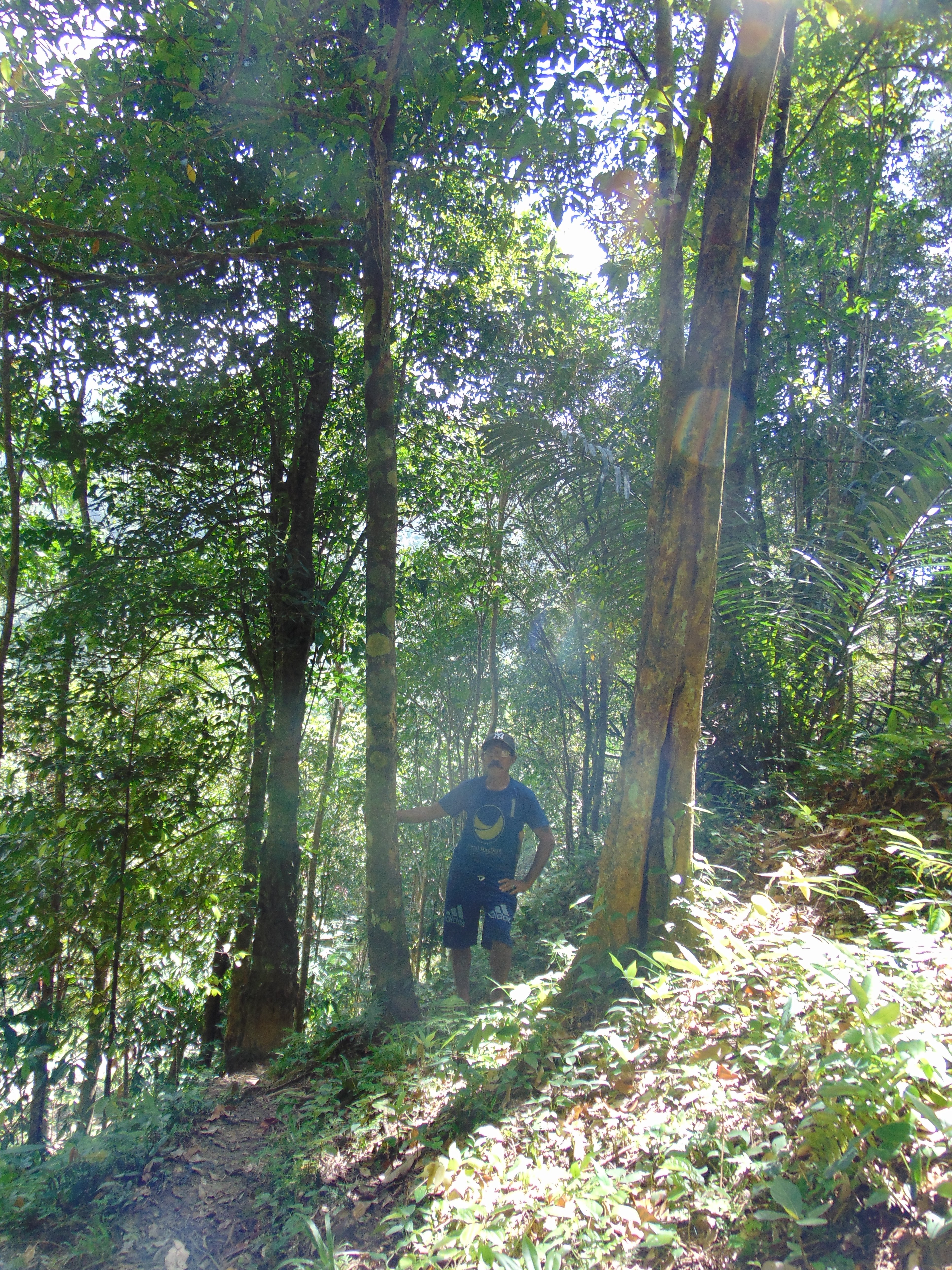Soil Organic Carbon in Forest and Other Land Use Types at Bengkulu City, Indonesia
Abstract
Conversion of natural forest into agricultural land uses has decreased soil organic carbon (SOC) and increased carbon emission into the atmosphere, but proper management of agricultural land can sequester carbon from the atmosphere and increase the SOC. This study was conducted to estimate the SOC content and storage in a forest, agroforestry land, oil palm plantation, and agricultural experimental field and to analyze the correlation between the SOC and other soil characteristics at Bengkulu City, Indonesia. Soil were sampled from the following depths: 0–10 cm, 10–20 cm, and 20–30 cm. The biomass of litter and ground cover was also sampled. This study found that the forest had the highest average SOC content from the three depths, and 0–30 cm depth SOC storage, while the agroforestry system had the lowest of both SOC content and storage. The 0–10 cm depth had the highest SOC content and storage, while the 20–30 cm depth had the lowest of both variables. The SOC was positively correlated with litter biomass, field capacity, exchangeable potassium, cation exchange capacity, and negatively correlated with bulk density and exchangeable calcium, but not correlated with total nitrogen and available phosphorus. High litter biomass input is the key to the maintenance of high SOC.
References
Agus, F., Yusrial, & Sutono, S. (2006a). Penetapan tekstur tanah. In In U. Kurnia, F. Agus, A. Adimihardja, & A. Dariah (Eds.), Sifat fisik tanah dan metode analisisnya (pp. 4362). Balai Besar Litbang Sumberdaya Lahan Pertanian.
Agus, F, Yustika, R. D., & Haryati, U. (2006b). Penetapan berat volume tanah. In U. Kurnia, F. Agus, A. Adimihardja, & A. Dariah (Eds.), Sifat fisik tanah dan metode analisisnya (pp. 2534). Balai Besar Litbang Sumberdaya Lahan Pertanian.
[BSN] Badan Standardisasi Nasional. (2011). SNI-7724 Pengukuran dan penghitungan cadangan karbon. Jakarta: BSN.
Deng, L., Zhu, G., Tang, Z., & Shangguan, Z. (2016). Global patterns of the effects of land-use changes on soil carbon stocks. Global Ecology and Conservation, 5, 127–138. https://doi.org/10.1016/j.gecco.2015.12.004
Eviati, & Sulaiman. (2009). Petunjuk teknis analisis kimia tanah, tanaman, air dan pupuk. Bogor: Balai Penelitian Tanah, Departemen Pertanian.
[FAO] Food and Agriculture Organization. (2017). Soil organic carbon: The hidden potential. Food and Agriculture Organization.
Farrasati, R., Pradiko, I., Rahutomo, S., Sutarta, E. S., Santoso, H., & Hidayat, F. (2020). C-organik tanah di perkebunan kelapa sawit Sumatera Utara: Status dan hubungan dengan beberapa sifat kimia tanah. Jurnal Tanah dan Iklim, 43(2), 157165. https://doi.org/10.21082/jti.v43n2.2019.157-165
Franzluebbers, A. J. (2021). Soil organic carbon sequestration calculated from depth distribution. Soil Science Society of America Journal, 85(1), 158–171. https://doi.org/10.1002/saj2.20176
Fusaro, C., Sarria-Guzmán, Y., Chávez-Romero, Y. A., Luna-Guido, M., Muñoz-Arenas, L. C., Dendooven, L., ..., & Navarro-Noya, Y. E. (2019). Land use is the main driver of soil organic carbon spatial distribution in a high mountain ecosystem. PeerJ, 7, e7897. https://doi.org/10.7717/peerj.7897
Gross, C. D., & Harrison, R. B. (2019). The case for digging deeper: Soil organic carbon storage, dynamics, and controls in our changing world "2279. 24.
Guo, Y., Wang, X., Li, X., Wang, J., Xu, M., & Li, D. (2016). Dynamics of soil organic and inorganic carbon in the cropland of upper Yellow River Delta, China. Scientific Reports, 6(1), 36105. https://doi.org/10.1038/srep36105
Hermawan, B., Suhartoyo, H., Sulistyo, B., Murcitro, B. G., & Herman, W. (2020). Diversity of soil organic carbon and water characteristics under different vegetation types in northern Bengkulu, Indonesia. Biodiversitas, 21(5), 17931799. https://doi.org/10.13057/biodiv/d210504
Jendoubi, D., Liniger, H., & Speranza, C. I. (2019). Impacts of land use and topography on soil organic carbon in a Mediterranean landscape (north-western Tunisia). SOIL, 5(2), 239–251. https://doi.org/10.5194/soil-5-239-2019
Kadlec, V., Holubík, O., Procházková, E., Urbanová, J., & Tippl, M. (2012). Soil organic carbon dynamics and its influence on the soil erodibility factor. Soil and Water Research, 7(3), 97108. https://doi.org/10.17221/3/2012-SWR
Kessler, M., Hertel, D., Jungkunst, H. F., Kluge, J., Abrahamczyk, S., Bos, M., ..., & Tscharntke, T. (2012). Can joint carbon and biodiversity management in tropical agroforestry landscapes be optimized? PLoS ONE, 7(10), e47192. https://doi.org/10.1371/journal.pone.0047192
Khasanah, N., van Noordwijk, M., Ningsih, H., & Rahayu, S. (2015). Carbon neutral? No change in mineral soil carbon stock under oil palm plantations derived from forest or non-forest in Indonesia. Agriculture, Ecosystems & Environment, 211, 195–206. https://doi.org/10.1016/j.agee.2015.06.009
Kome, G. K., Enang, R. K., & Yerima, B. P. K. (2021). Soil organic carbon distribution in a humid tropical plain of Cameroon: Interrelationships with soil properties. Applied and Environmental Soil Science, 2021, 1–18. https://doi.org/10.1155/2021/6052513
Kong, A. Y. Y., Six, J., Bryant, D. C., Denison, R. F., & van Kessel, C. (2005). The relationship between carbon input, aggregation, and soil organic carbon stabilization in sustainable cropping systems. Soil Science Society of America Journal, 69(4), 1078–1085. https://doi.org/10.2136/sssaj2004.0215
Lal, R. (2020). Managing soils for negative feedback to climate change and positive impact on food and nutritional security. Soil Science and Plant Nutrition, 66(1), 1–9. https://doi.org/10.1080/00380768.2020.1718548
Li, M., Xiong, Y., & Cai, L. (2021). Effects of biochar on the soil carbon cycle in agroecosystems: An promising way to increase the carbon pool in dryland. IOP Conference Series: Earth and Environmental Science, 693(1), 012082. https://doi.org/10.1088/1755-1315/693/1/012082
Mackey, B., Kormos, C. F., Keith, H., Moomaw, W. R., Houghton, R. A., Mittermeier, R. A., ..., & Hugh, S. (2020). Understanding the importance of primary tropical forest protection as a mitigation strategy. Mitigation and Adaptation Strategies for Global Change, 25(5), 763–787. https://doi.org/10.1007/s11027-019-09891-4
McCauley, A., Jones, C., & Olson-Rutz, K. (2017). Nutrient management module 08: Soil pH and organic matter. Montana State University Extension. http://msuextension.org/publications/AgandNaturalResources/NM8.pdf
Minasny, B., Malone, B. P., McBratney, A. B., Angers, D. A., Arrouays, D., Chambers, A., …, & Winowiecki, L. (2017). Soil carbon 4 per mille. Geoderma, 292, 5986. https://doi.org/10.1016/j.geoderma.2017.01.002
Muchane, M. N. (2020). Agroforestry boosts soil health in the humid and sub-humid tropicsA meta-analysis. Agriculture, Ecosystem and Environment, 295, 106899. https://doi.org/10.1016/j.agee.2020.106899
Murphy, B. (2015). Key soil functional properties affected by soil organic matter – Evidence from published literature. IOP Conference Series: Earth and Environmental Science, 25, 012008. https://doi.org/10.1088/1755-1315/25/1/012008
Namirembe, S., Piikki, K., Sommer, R., Söderström, M., Tessema, B., & Nyawira, S. (2020). Soil organic carbon in agricultural systems of six countries in East Africa – A literature review of status and carbon sequestration potential. South African Journal of Plant and Soil, 37(1), 35–49. https://doi.org/10.1080/02571862.2019.1640296
Navarro-Pedreño, J., Almendro-Candel, M. B., & Zorpas, A. A. (2021). The increase of soil organic matter reduces global warming, myth or reality? Sci, 3(1), 18. https://doi.org/10.3390/sci3010018
Oldfield, E. E., Bradford, M. A., & Wood, S. A. (2019). Global meta-analysis of the relationship between soil organic matter and crop yields. Soil, 5, 1531. https://doi.org/10.5194/soil-5-15-2019
Ravindranath, N. H., & Ostwald, M. (2008). Carbon inventory methods handbook for greenhouse gas inventory, carbon mitigation and roundwood production projects. Netherlands: Springer. https://doi.org/10.1007/978-1-4020-6547-7
Rawls, W. J., Pachepsky, Y. A., Ritchie, J. C., Sobecki, T. M., & Bloodworth, H. (2003). Effect of soil organic carbon on soil water retention. Geoderma, 116(1–2), 61–76. https://doi.org/10.1016/S0016-7061(03)00094-6
Signor, D., Deon, M. D., Camargo, P. B. de, & Cerri, C. E. P. (2018). Quantity and quality of soil organic matter as a sustainability index under different land uses in Eastern Amazon. Scientia Agricola, 75(3), 225–232. https://doi.org/10.1590/1678-992x-2016-0089
Soto-Pinto, L., Anzueto, M., Mendoza, J., Ferrer, G. J., & de Jong, B. (2010). Carbon sequestration through agroforestry in indigenous communities of Chiapas, Mexico. Agroforestry Systems, 78(1), 39–51. https://doi.org/10.1007/s10457-009-9247-5
Steel, R. G. D., & Torie, J. H. (1980). Principles and procedures of statistics. A biometrical approach (2nd ed.). McGraw-Hill Book Company.
Stella, T., Mouratiadou, I., Gaiser, T., Berg-Mohnicke, M., Wallor, E., Ewert, F., & Nendel, C. (2019). Estimating the contribution of crop residues to soil organic carbon conservation. Environmental Research Letters, 14(9), 094008. https://doi.org/10.1088/1748-9326/ab395c
Sudirman, Sutono, S., & Juarsa, I. (2006). Penetapan retensi air tanah di laboratorium. In Sifat Fisik Tanah dan Analisisnya. Balai Besar Litbang Sumberdaya Lahan Pertanian.
van Straaten, O., Corre, M. D., Wolf, K., Tchienkoua, M., Cuellar, E., Matthews, R. B., & Veldkamp, E. (2015). Conversion of lowland tropical forests to tree cash crop plantations loses up to one-half of stored soil organic carbon. Proceedings of the National Academy of Sciences, 112(32), 9956–9960. https://doi.org/10.1073/pnas.1504628112
Wang, F. L., & Huang, P. M. (2001). Effects of organic matter on the rate of potassium adsorption by soils. Canadian Journal of Soil Science, 81(3), 325–330. https://doi.org/10.4141/S00-069
Wasis, B. (2012). Soil properties in natural forest destruction and conversion to agricultural land, in Gunung Leuser National Park, North Sumatera Province. Jurnal Manajemen Hutan Tropika, 18(3), 206212. https://doi.org/10.7226/jtfm.18.3.206
Zhou, W., Han, G., Liu, M., Zeng, J., Liang, B., Liu, J., & Qu, R. (2020). Determining the distribution and interaction of soil organic carbon, nitrogen, pH and texture in soil profiles: A case study in the Lancangjiang River Basin, Southwest China. Forests, 11(5), 532. https://doi.org/10.3390/f11050532
Authors

This work is licensed under a Creative Commons Attribution 4.0 International License.
Jurnal Manajemen Hutan Tropika is an open access journal which means that all contents is freely available without charge to the user or his/her institution. Users are allowed to read, download, copy, distribute, print, search, or link to the full texts of the articles in this journal without asking prior permission from the publisher or the author. This is in accordance with the Budapest Open Access Initiative (BOAI) definition of open access.









